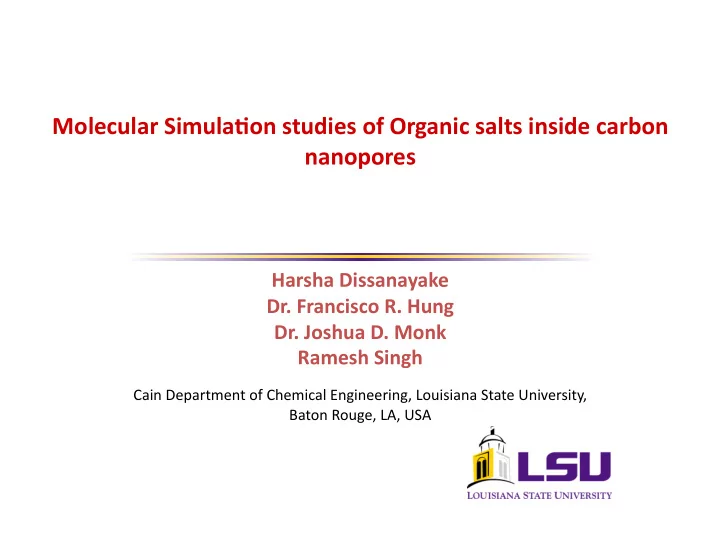

Molecular Simula-on studies of Organic salts inside carbon nanopores Harsha Dissanayake Dr. Francisco R. Hung Dr. Joshua D. Monk Ramesh Singh Cain Department of Chemical Engineering, Louisiana State University, Baton Rouge, LA, USA
What are Ionic liquids? An ionic liquid is a salt in liquid phase at room • temperature. Made up of ions and have ionic bonds. • Posses low vapor pressure and are moderate or low • electric conductors. 1,3‐dimethylimidazolium chloride • Highly tunable properIes; 10 9 ‐ 10 18 ILs could be [DMIM+][Cl‐] formed by varying caIons, anions. • Vast number of applicaIons due to disInct properIes in many fields such as Organic chemistry, Engineering, Electro chemistry, Catalysis and Physical chemistry. (Solvents, electrolytes, etc)
Importance of Ionic Liquids(IL’s) IL’s can be synthesized to possess fluorescent, magneIc and many other qualiIes according to necessity. Ionic liquids can be synthesized from safe, FDA‐ approved compounds; therefore could be used in Bio‐medical applicaIons. Nanomaterials with fluorescent proper-es can be used • to label Issues and cells for biomedical imaging Image courtesy of the Warner group [PF 6 ˉ ] Nanomaterials with magne-c proper-es can be used in • cancer treatment (magneIc hyperthermia). Aber 1‐butyl‐2,3‐methylimidazolium acaching them to cancer cells, the paIent can be hexafluorophosphate, exposed to a safe magne-c field and the heat generated [bm 2 im + ][PF 6 ˉ ] by the magneIc nanoparIcles will destroy the respecIve cancer cells that they are acached to.
Why molecular simulaIon? The properIes of ionic liquids confined inside • nanopores can be very different from what we see in day to day usage (bulk systems). It is extremely difficult to extract experimental • data regarding such systems Molecular dynamics (MD) simulaIon is a very • useful technique in such cases to give insights to experimental scienIsts and to complement their observaIons regarding properIes and characterisIcs of molecules at nanolevel.
Overview of simula-on methods Continuum Methods TIME /s 10 0 Mesoscale methods Atomistic simulation (ms) 10 -3 Lattice Monte Carlo methods Brownian dynamics Dissipative particle dynamics ( µ s) 10 -6 Semi-empirical (ns) 10 -9 methods Monte Carlo Molecular dynamics (ps) 10 -12 Ab initio methods tight-binding MNDO, INDO/S 10 -15 (fs) 10 -10 10 -9 10 -8 10 -7 10 -6 10 -5 10 -4 (nm) ( µ m) 5 LENGTH/meters
Molecular dynamics: a quick introduc-on • In molecular dynamics (MD), we follow the posiIons and velociIes of each molecule in Ime by solving Newton’s equaIons of moIon: i= 1,2,3,… N U = inter/intra‐molecular potenIal (i.e., interacIons between atoms) r i = posiIon vector of atom i F i = force acIng over atom i m i = mass of atom i • In MD these equations are integrated numerically to obtain the time evolution of the system 6
Pair Poten-als: Large, Flexible Mols. • Total pair energy breaks into a sum of terms: DNA U str ‐ stretch • U bend ‐ bend • U tors ‐ torsion • U disp ‐ dispersion (van der Waals) • U elec ‐ electrostaIc • U pol ‐ polarizaIon • 7
System to be studied 1,3‐dimethylimidazolium chloride [DMIM+][Cl‐] MulI‐walled carbon nanotube Molar mass ‐ 132.5 mols/gram hcp://www.photon.t.u‐tokyo.ac.jp/~maruyama/agallery/ nanotubes/mwnt.gif • In my summer project I will be invesIgaIon various properIes of the ionic liquid [DMIM+][Cl‐] when it is confined in a mulI‐walled carbon nanotube. • I will be using Gromacs MD sobware to perform MD simulaIons of [DMIM+][Cl‐] Maolin Sha, Guozhong Wu, Haiping Fang, Guanglai Zhu, and Yusheng Liu J. Phys. Chem. C, 2008, 112 (47), 18584‐18587• DOI: 10.1021/jp8079183 • Publica?on Date (Web): 30 October 2008
[DMIM+][Cl‐] molecules inserted into carbon nanotube System without [Cl‐] atoms
Minimized Energy IniIal Melted state state configuraIon The [Cl‐] ion has not been depicted for visualizaIon purposes.
Aber running the system under bath condiIons for approximately 10ns we can extract the data and analyze it to understand the molecular‐level properIes and characterisIcs of the system. This informaIon can be useful to experimentalists. Density 800 600 400 Density 200 10 per. Mov. Avg.(Density) 0 4 rdf 3.5 rmsd 3 1.2 2.5 1 2 0.8 rmsd 0.6 1.5 rdf 0.4 10 per. Mov. Avg. 1 0.2 10 per. Mov. Avg.(rdf) (rmsd) 0 0.5 0 700 1400 2100 2800 3500 4200 4900 5600 6300 7000 7700 0 0 0.078 0.156 0.234 0.312 0.39 0.468 0.546 0.624 0.702 0.78 0.858 0.936 1.014 1.092 1.17 1.248 1.326 1.404 1.482
End
Molecular dynamics: Introduc-on • MD simula5ons are similar to real experiments • In a basic MD simulaIon program: • ‘Prepare the sample’: • IniIal energy (or temperature) • Number of parIcles N • Box size ( N / L 3 = density) • Force field equaIons, parameters • Time step dt for integraIng equaIons of moIon • IniIalize posiIons and velociIes of all parIcles • ‘Do the experimental measurement’: • Compute forces on all parIcles • Integrate Newton’s equaIons ( F = m a ) Repeat unIl we reach an appropriate ‘simulated Ime’ • Update parIcle posiIons and velociIes • Calculate instantaneous properIes • Stop aber iteraIng t max steps 13
Recommend
More recommend